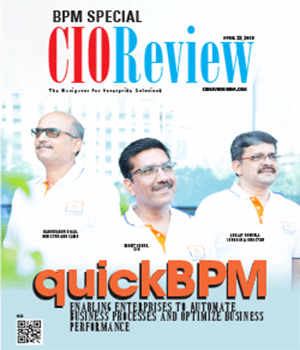
The Digitization Journey
Sreenivas Pamidimukkala, CIO, International Paper
 Digitization is way of converting information into digital format automating the manual process. There will be lot of areas where digitization helps. Areas that provide huge business value should be chosen for digitization. Advantages of digitized data are
Digitization is way of converting information into digital format automating the manual process. There will be lot of areas where digitization helps. Areas that provide huge business value should be chosen for digitization. Advantages of digitized data are
a. Data Foundation
b. Data Retention
Once data foundation is created, this data can be used for future trends. There are lot of emerging technology tools that can be used for creating trends like Tableau and Power BI.
Data retention: Data will be stored in a database for further use. This data can be used for future trends and dashboards.
Organization that wants to start the digitization journey should focus on 5 important things:
1. Strategy
2. Executive Sponsor & Stakeholder Commitment
3. Organization Readiness
4. Communication
5. Project Team
Strategy: When we start the digitization initiative there will be lot of opportunity. Strategy document is more important for the organization. This strategy should be only for 3 years. This document will give the road map on how Digitization will be implemented in an organization. Strategy document should always have timelines.
Executive Sponsor & Stakeholder Commitment: This strategy should be part of Organization's goals. After that all the relevant stakeholders and the Leadership team should be committed to this goal. This is extremely important that the leadership is aligned in the strategy. We will also see the impact of the changes and what can be done to reduce the impact. Their acceptance and support is the key to your success.
"By assessing the organization’s change readiness, one can better plan and prepare the organization for the changes ahead. This will allow for identification and understanding of potential enablers and potential barriers"
Six key questions to identify Stakeholder Concerns & Issues
a. What is changing?
b. Why is it changing?
c. How will I be impacted?
d. What is in it for me?
e. How will I get the knowledge, skill and information that I need?
f. What do you need for me to do?
Organization Readiness: The organization's capability to adapt to and sustain the changes associated with different business initiatives is important. By assessing the organization’s change readiness, one can better plan and prepare the organization for the changes ahead. This will allow for identification and understanding of potential enablers and potential barriers. The readiness assessment will also surface organizational issues and opportunities that need to be addressed. You will always here “Existing system is working fine” why change. IT will always come up with new things. The key elements of change readiness are:
a. Change Vision
b. Change Leadership
c. Building Commitment
d. Sustaining Change
e. Configuring and Managing the Change Program
Communication: This consists of 2 important steps:
a. Communication Strategy
b. Communication Plan
Communication Strategy has the following key elements:
a. Audience
b. Message
c. Channels
d. Timeframe
e. Sender
f. Feedback
Communication Plan: Simple chart to help people understand the channels, content and action needed for communication. The process by which information is exchanged between individuals through a common system of symbols, signs and behaviours. By using this we can:
a. Inform and Involve team members
b. Build awareness and understanding for the change
c. Communicate a consistent message
Benefits of Communication:
a. Inform & Involve those impacted
b. Develop awareness & understanding for the project
c. Articulate project vision in consistent message
d. Replace rumours with facts, reducing anxiety levels
A clearly defined communication plan will:
a. Guide distribution of key project messages to employee population
b. Identify how the right messages go to the right audience at the right time with the right level of impact
Project Team: Good team always wins. Make sure you have the right resources working on the projects. This will make a huge difference. Team readiness provides individuals with the necessary direction, tools & support to implement the changes related to the project. Team readiness is important because:
a. It provides clear direction a common team goal
b. Provides clear involvement and commitment to team and individual roles and responsibilities.
c. Ensures that individuals have the skills and knowledge needed to execute their role
d. Open and effective communication channels
Characteristics of Successful Teams:
a. A Common Goal
b. Agreement on how the team will function
c. Cleary defined expectations, milestones and accountabilities
d. A focus on solving problems and self-correcting their own internal team functioning
e. Highly developed interpersonal and team skills
f. Provide a supportive environment for team members
g. A focus on continuous improvement
Setting Up for Success:
a. Team process is like any technical process: teams will deliver only what they are capable of delivering
b. A team not formed properly could stay in the “storming” stage for a period of time
c. Unless intervention occurs, teams norms will reinforce the team’s ineffective group dynamics
d. Setting up for success accelerates the team’s ability to be productive, to reach the performing stage and achieve their deliverables with little or no disruptions
e. Provide the team necessary training and guidance for the initiative to be successful.
CIO Viewpoint
Gen AI: Transforming Cloud Solutions for...
By Matt Yanchyshyn, VP - AWS Marketplace & Partner Services, AWS
Upcoming Technological Advancements in Payments...
By Pinak Chakraborty, CIO of Airtel Payments Bank
Shaping the Future of AI: Talent, Innovation,...
By Yann LeCun, Chief AI Scientist at Meta
CXO Insights
Looking towards Operations Management: What...
By Dr. Vandana Sonwaney, Director, SIOM
Strategic Implementation And Control
By SURESH.V. MENON-PRINCIPAL CONSULTANT SIX SIGMA & STRATEGIC MANAGEMENT, ADVISORY (BUSINESS EXCELLENCE)
Grand Strategies Used In Strategic Management









